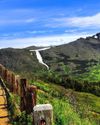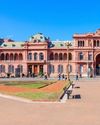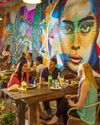Tour Colombia for a dose of coffee harvesting, brewing and tasting.

“HOW MANY OF YOU PUT sugar in your coffee?” asked the barista at Café Jesús Martín in Salento. Five of the seven in our group raised their hands sheepishly. “I don’t blame you,” he answered, surprising us. “Most of the coffee you get is probably so bad that you need sugar to make it drinkable.” With a smile he added, “We’re not going to drink coffee like that today.”
When our perfectly made cappuccinos arrived, carefully brewed with freshly roasted beans from one of the best local farms, we had to admit he was right. This did not taste like the usual burnt black liquid from a corporate coffee chain or — even worse — your average diner. This brew was complex, rich, bursting with flavor and balanced. This is what it tastes like to drink good coffee at its source.
Coffee didn’t start out in Colombia, of course. The beans we now consume by the ton each day originated in some of the oldest human lands in Ethiopia, then made their way to Yemen. Eventually the bushes themselves migrated around the world to appropriate climates. In the 20th century, Colombia became the country most associated with coffee. While it has never been the biggest producer by volume, it has been the biggest quality producer.
この記事は Global Traveler の December 2017 版に掲載されています。
7 日間の Magzter GOLD 無料トライアルを開始して、何千もの厳選されたプレミアム ストーリー、9,000 以上の雑誌や新聞にアクセスしてください。
すでに購読者です ? サインイン
この記事は Global Traveler の December 2017 版に掲載されています。
7 日間の Magzter GOLD 無料トライアルを開始して、何千もの厳選されたプレミアム ストーリー、9,000 以上の雑誌や新聞にアクセスしてください。
すでに購読者です? サインイン

Nurturing Nature
Connect with the abundant flora and fauna of Belize.

Sojourn by the Sea
Discover plenty to smile about in Thailand’s exotic islands.

Colorado Dreaming
For family ski fun, Snowmass and Beaver Creek steal the show.

The Great Outdoors
Anchorage opens the door to all that is wild in Alaska.

Buenos Aires on Foot
Hit the highlights with online itineraries and the city’s free app.

Above and Beyond
Global Traveler celebrates the 2021 winners of the GT Tested Reader Survey awards.

Wellness Wonderland
Reboot at Lake Austin Spa Resort in Texas Hill Country.

Good Vibes
Adelaide’s West End thrives as a hip urban hub close to nature.

Solo Voyages
Cruise lines adapt policies to accommodate those traveling alone.

Grand Slam
Follow the pro tennis tour around the world.